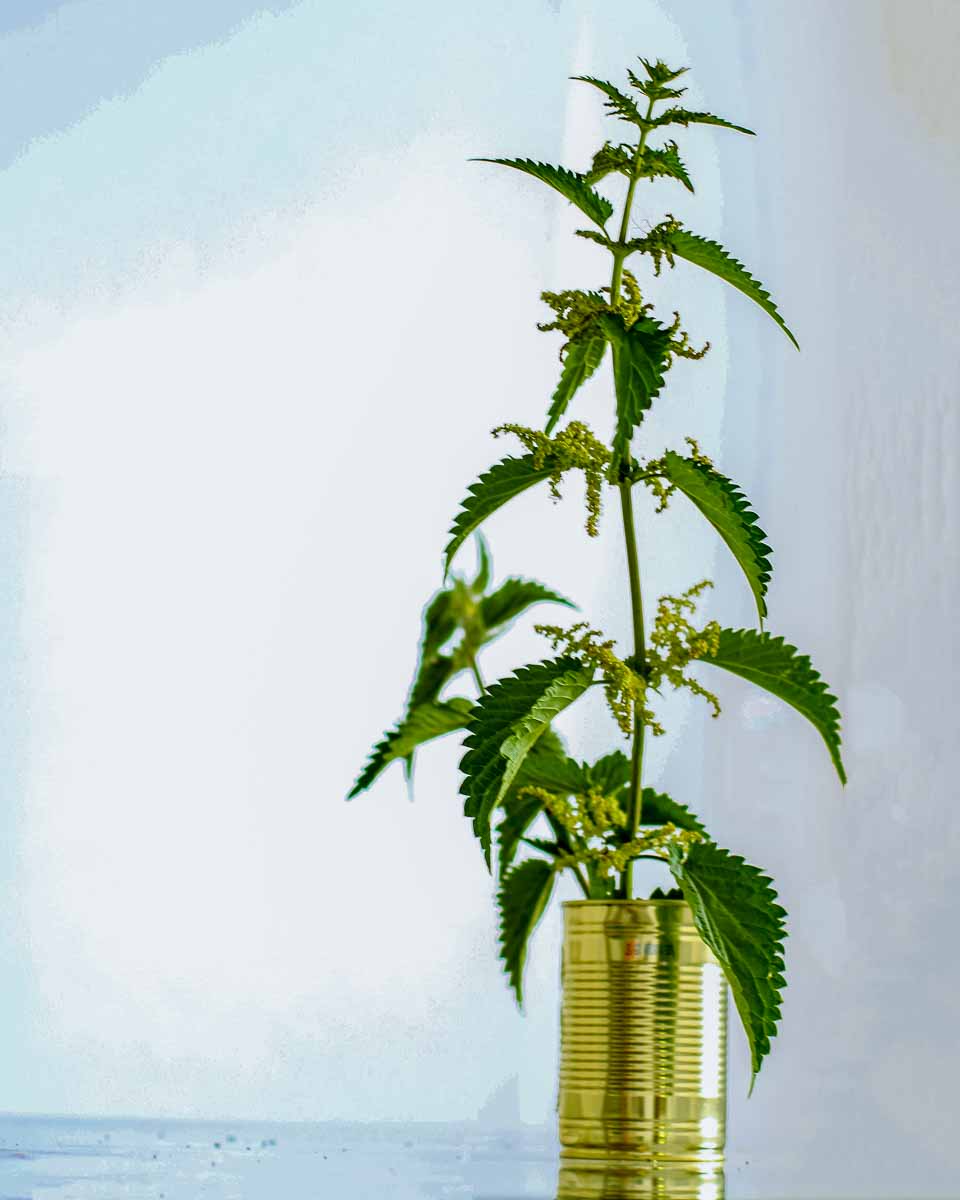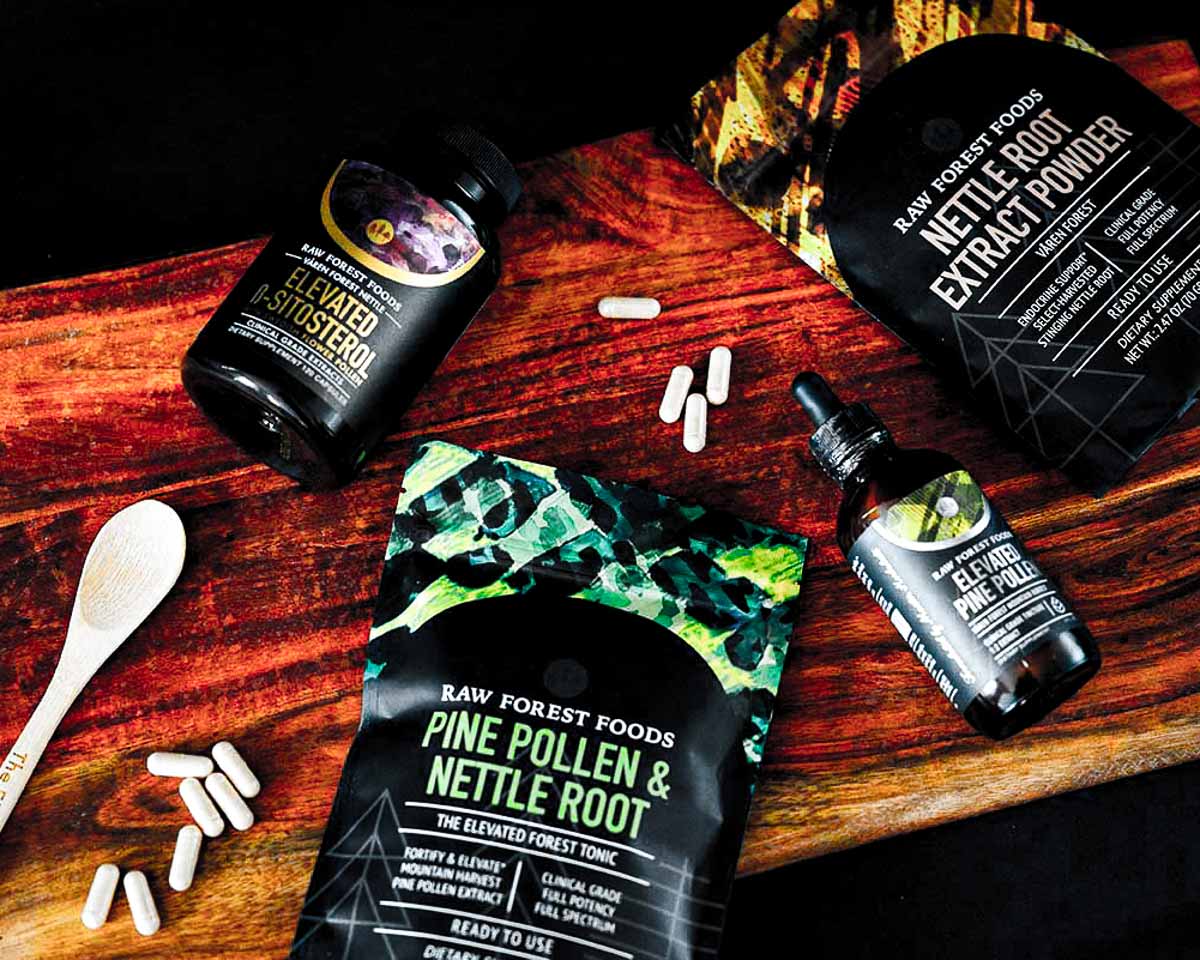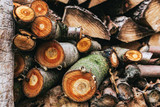Nettle Root and Women's Hormonal Health
Nettle Root and Hormones: Using Nettle Root to Support Women's Endocrine Health and Manage Polycystic Ovarian Syndrome (PCOS)
Many people who have spent time in forests and woods are already familiar with the sting of Stinging Nettle, and many women are acquainted with the phyto-therapeutic uses and health benefits of Nettle Leaf. Here, we will explore the use of Nettle Root in supporting women's hormonal health, including its important benefits for managing Polycystic Ovarian Syndrome (PCOS).
Nettle has been consumed for a long time in Asia, Europe, and South Africa; and its use in the US has begun to surge, with an increasing number of women and men using both Nettle Leaf and Nettle Root.
Stinging Nettle is an essential and powerful herb that has secured its position in the Western herbal pharmacopeia. The use of Nettle (Urtica dioica), whether you call it Nettle, Stinging Nettle, or just an annoyance while you're out hiking, dates back over 2000 years and has long been used as a top spring tonic alongside Dandelion Leaf and Dandelion Root.
The association between wild Nettle and its painful stings has resulted in this nutrition powerhouse being neglected and frowned upon. But is Nettle merely a bothersome pest, just a nuisance, or is it a phytotherapeutic herbal medicine and functional food?
We conducted the research, and this is what we discovered.
 A Brief History of the Medicinal Uses of Nettle: Nettle's Use in Traditional Medicine Systems
A Brief History of the Medicinal Uses of Nettle: Nettle's Use in Traditional Medicine Systems
Nettle leaves, roots, and stems have a long history of use in various traditional medicine systems.
Nettle in Chinese Herbal Medicine
In Chinese herbalism, both in Classical and Traditional Chinese Medicine (TCM), Nettle Seed is believed to contain tonifying properties, nurturing Yang energy and strengthening Yuan, commonly known as Jing, Kidney Yang, or Kidney Yin.
In this way, Nettle is used to restore the balance of Yin and Yang—the two opposite but interdependent forces essential for optimal health.
Nettle in Ayurvedic Medicine
It is revered for its nourishing and rejuvenating effects and is said to have soothing effects on the kidneys and adrenal glands. Ayurvedic practitioners recommend nettle to increase vitality (Ojas) in people recovering from an illness
In Ayurveda, the traditional system of medicine and healthcare in India, Nettle is considered to have a balancing effect on Vata, Pitta, and Kapha—the three types of energy (doshas) of the human body.
Here, we see a synonymous use of Nettle within these two systems of traditional medicine.
Nettle in Egyptian and European Uses
Ancient Egyptians used Nettle infusions to relieve arthritis pain, lethargy, and swelling.
Greek physicians Hippocrates and Galen recommended it for diuresis, menstrual disorders, asthma, and chest pain.
During the Dark Ages (5th to 10th centuries) in Europe, people used nettle to treat shingles, constipation, and disorders of the skin and lungs.
From the 16th to the 19th century, its use expanded to a wide range of health issues, including:
- Poisoning
- Skin infections
- Gout
- Kidney stones
- Eczema
Nettle and the Modern German Pharmacopoeia (DAB)
Notably, Germany's prestigious Kooperation Phytopharmaka has included Nettle in its Encyclopaedia of Medicinal Plants (1) . Additionally, the German authorities have approved Nettle Roots for treating prostate cancer, rheumatism, and kidney infections (2) .
 What Exactly are Nettle Leaf and Nettle Root, and Why are They Important?
What Exactly are Nettle Leaf and Nettle Root, and Why are They Important?
Also called Stinging Nettle or Common Nettle, Nettle is an herbaceous plant native to Europe, Asia, northern Africa, and North America and is now found throughout many regions of the world. In the US, it is additionally referred to as Tall Nettle, California Nettle, or Slender Nettle.
Stinging Nettle belongs to the genus Urtica of the family Urticaceae. There are about 25 different species within the genus Urtica. Among them, Urtica dioica is the most commonly found species in the US.
Nettle plants occur in most parts of the US, Canada, and south along the west coast to Mexico (3) . Nettle is typically found growing in marshes and meadows where the soil is soft and black, and it often pops up after the earth is disturbed by logging, fire, agriculture, construction, and other human activities. It can also be found in any moist site in or close to open forests and ditches.
A fully grown plant can reach a height of over 4 feet (hence the name Tall Nettle), with leaves and stalks covered in tiny stinging hairs called trichomes. The hairs contain formic acid and histamine, and touching them can cause pain, itching, and redness. The leaves are oval-shaped, toothed, and the flowers are green to yellow.
Once dried or cooked (even lightly steamed), Nettle loses its ability to sting as the trichomes (the tiny hairs responsible for its sting) become deactivated, and the plant no longer poses any threat.
The Nettle Nutrition Fact-Sheet
Nettle Leaf is known to be deeply nutritive as food (a good source of vitamin A and calcium) and as tea. It is also known to improve skin, hair, and nail health.
- Nettle Leaf contains twice as much protein as spinach and parsley (4) .
- Nettle Leaf is a richer source of essential amino acids than Brussels sprouts and contains almost as many essential amino acids as almonds (by weight). It contains generous amounts of threonine, valine, isoleucine, leucine, phenylalanine, and lysine.
- The leaves, seeds, stems, and roots have high levels of heart-healthy fats, such as oleic, linoleic, and alpha-linolenic acids.
- One gram of Nettle Leaf powder contains twice as much phenolic content as 100 mL of cranberry juice. Phenolic compounds are found in fruits, vegetables, legumes, and herbs. These substances have potent antioxidant, anti-inflammatory, anti-allergic, anticancer, antihypertensive, anti-arthritic, and antimicrobial properties (5) .
- 100 g of raw Stinging Nettle Leaf contains 499 mg of vitamin K, making it one of the richest plant sources of the vitamin (6) .
- The leaves contain high amounts of minerals, such as calcium, potassium, magnesium, phosphorus, iron, sulfur, zinc, manganese, copper, nickel, and selenium (4) .
Nettle Is Rich in Numerous Therapeutic Compounds
In addition to nutrients, Nettle also contains incredibly beneficial medicinal chemicals. The occurrence and amounts of these chemicals can vary depending on the origin, time of sample collection, and the part of the plant.
Nettle Stems and Leaves, the Aerial Parts of the Plant, Contain the Following Therapeutic Substances (7):
- Flavonoids: Rutin and rutinoside;
- Organic Acids: Caffeic acid, ferulic acid, chlorogenic acid, citric acid, and fumaric acid;
- Essential Oils: Carvacrol, naphthalene, and phytol;
- Chlorophyll, tannins, and carotenoids (precursors to Vitamin A).
Nettle Leaf is relatively common within herbalism here in the US, but few know of the health benefits of Stinging Nettle Root. Harvested in the fall before the ground freezes and transitions to a blustery winter, Nettle Root—as we will see below—is a gift to hormonal health.
Nettle Root Contains the Following Therapeutic Substances:
- Amino Acids: glycine, cysteine, and tryptophan;
- Flavonoids: myricetin, quercetin, kaempferol, and rutin;
- Phytosterols: β-sitosterol, 7β-hydroxysitosterol, 7α-hydroxysitosterol, and stigmasterol.
The Health Benefits of Nettle Root for Women
Nettle Root and Hormonal Health: What You Need to Know
Numerous therapeutic compounds in Nettle Root have a significant impact on male and female hormones.
A Quick Introduction to Hormones and the Endocrine System
Hormones are chemical messengers produced by the endocrine glands. These glands constitute a system known as the endocrine system, which regulates:
- Growth and metabolism
- Sexual function
- Reproduction
- Heart rate and blood pressure
- Appetite
- Sleeping and waking cycles
- Body temperature.
Some of the more well-known endocrine glands are:
- The pituitary gland, which produces hormones that regulate the function of other glands, including sex hormones in women and men;/li>
- The thyroid gland, which produces thyroid hormones;
- The adrenal glands, which produce sex hormones and the stress hormone called cortisol;
- The pancreas, which produces insulin.
Once released from a gland, hormones enter the bloodstream. From there, they travel to the target tissues or cells in the body. These cells have specific identification sites called receptors. The hormone binds to the receptors and regulates the functions specific to those receptors.
For example, insulin tells the muscle and fat cells to absorb sugar from the bloodstream.
Nettle Root, Sex Hormone-Binding Globulin, and Aromatase
For both men and women, two important substances keep hormone levels in balance: Sex Hormone-Binding Globulin (SHBG) and Aromatase. Nettle Root produces a balancing and modulating effect on hormone levels through its influence on these two substances.
Sex Hormone-Binding Globulin (SHBG)
Sex Hormone-Binding Globulin is a protein made by the liver. SHBG binds to and carries three hormones in men and women: estrogen, dihydrotestosterone (DHT), and testosterone. Of the three hormones, testosterone is the most clinically relevant.
High SHBG levels mean that little testosterone is available to the tissues, which can result in decreased sexual desire and satisfaction in women. In men, low testosterone can cause erection issues and impaired sex drive.
Low SHBG levels indicate abnormally high levels of testosterone. High testosterone levels can cause polycystic ovary syndrome (PCOS) in women and can lead to aggression, depression, irritability, hair loss, and an enlarged prostate in men.
Aromatase
This enzyme converts testosterone to estrogen. High levels of aromatase accelerate testosterone depletion and estrogen production. While the conversion is a natural process, dysregulation of aromatase can result in too much estrogen or too little testosterone.
In men, high levels of aromatase may cause breast enlargement (gynecomastia), whereas in women, it can cause irregular menstrual cycles
The Health Effects of Estrogen in Men and Women
Many of us know estrogen as a female sex hormone. However, only a few know that it is also essential for male reproductive function.
In men, estradiol (a form of estrogen) plays a crucial role in regulating sex drive, erectile function, and spermatogenesis (8) .
Excess estrogen in men has been implicated in infertility, enlarged breasts, and erectile dysfunction.
In women, the ovaries produce a large portion of estrogen. It is central to the development of sexual function and female characteristics.
Low estrogen in women can cause hot flashes, severe mood swings, vaginal dryness, and wrinkles. Conversely, excess estrogen (sometimes called estrogen dominance) can cause breast lumps, irregular periods, breast pain, mood swings, and memory problems.
How Does Nettle Root Help with Hormone Balance in Women?
For women, the health benefits of Nettle Root and its effects on the body are similar to those of men: optimizing and regulating the endocrine (hormone) system.
Why is Hormone Balance Critical for Women?
Unlike men, women tend to undergo extreme hormonal fluctuations due to a variety of factors, including menstrual cycles, pregnancy, menopause, breastfeeding, and the use of birth control pills.
Hormone imbalance, notably excess estrogen, has been linked to a higher risk of breast cancer (9) .
Researchers believe that the longer the duration of estrogen exposure, the higher the risk of breast cancer. This can happen when you have an early first period and delayed menopause.
Nettle Root and Sex Hormone Binding Globulin (SHBG): Optimizing Sex Hormone Levels
Through its unique actions on Sex Hormone-Binding Globulin (SHBG), Nettle Root has the ability to add sex hormones where they are needed and remove them where they are not. Additionally, through Nettle Root's action on the enzyme aromatase, it can prevent the conversion (aromatization) of estradiol, an estrogen metabolite that can cause damage.
The best thing about Nettle for hormone health is that it aids hormone production when levels drop and reduces hormone release when your body already has enough of it.
Nettle Root for Managing Aromatase and Estradiol
As mentioned above, Nettle Root can minimize harmful estrogen metabolites in the body for both women and men. Sex hormones undergo a process called aromatization, where the end products are implicated as primary causative factors in several types of cancer, including hormone-receptor-positive breast cancer and uterine cancer.
Decreasing levels of these estrogen metabolites have shown benefits both in assisting cancer prevention and as an adjunct therapy.
Conventional medicine has identified the importance of blocking the process of aromatization by blocking the enzyme aromatase—the same enzyme and process that Nettle Root blocks. In fact, three of the most common breast cancer drugs all work to lower estradiol (e2) levels by blocking aromatase (Arimidex (anastrozole), Aromasin (exemestane), and Femara (letrozole)).
The method of action (MoA) of this class of medication works similarly to Nettle Root, as the ß-Sitosterol present in Nettle Root blocks the aromatization process.
Nettle Root and Aromatase: Compounds in Nettle Root Block Aromatase Activity
In both women and men, the enzyme aromatase converts testosterone to estradiol (e2) through a process called aromatization. While certain levels of estradiol are healthy in the body, high levels of the hormone are implicated in many conditions, syndromes, and diseases, including some forms of breast cancer.
High levels of aromatase in women can cause early first periods, irregular cycles, an enlarged uterus, and uterine bleeding (10) . Fatty substances, specifically ß-Sitosterol (Beta-Sitosterol), present in Nettle Root possess potent aromatase inhibitory activity (11) .
ß-Sitosterol in Nettle Root can decrease the activity of aromatase, thereby reducing the loss of testosterone to estradiol and subsequently decreasing levels of estradiol. For this specific reason, Nettle Root is included in the prestigious German Pharmacopoeia (DAB).
Aromatase inhibitors are effective in treating breast cancer in postmenopausal women (12) . In one recent study, Italian researchers found that flavonoids in the root can prevent or reduce cancer (13) .
Nettle Root and Polycystic Ovarian Syndrome

Nettle May Help Manage and Relieve PCOS Symptoms
Polycystic ovarian syndrome (PCOS) is the leading cause of infertility in women of childbearing age.
Women with the condition have an excess of male hormones (testosterone) in their bodies. This hormone imbalance causes irregular periods, acne, and excess hair growth. Moreover, some women may struggle with getting pregnant.
Unmanaged or poorly treated PCOS may lead to type 2 diabetes and heart disease.
In the clinic, and for the audience at large, an increasing number of herbalists are integrating and using Nettle Root in the treatment and management of polycystic ovarian syndrome (PCOS), commonly referred to as polycystic ovarian disorder (PCOD).
Linda Crockett, author of "Healing Our Hormones, Healing Our Lives," includes Nettle Root in her formulas for treating PCOS, and many naturopathic doctors and herbalists are currently working with Nettle Root to treat PCOS.
Polycystic ovarian syndrome is one of the most common endocrine disorders plaguing women, and it seems that more and more women are suffering from PCOS. The effects of PCOS are severe and affect many areas of a woman's life in a multitude of ways. Polycystic ovarian syndrome causes a lack of ovulation, known as anovulation (the prefix of a or an = without).
Anovulation results in irregular and absent menstruation (amenorrhea). PCOS also causes ovulation-related infertility and polycystic ovaries. PCOS leads to an excess of androgenic hormones (the male sex hormones), which often results in acne and excessive hairiness (hirsutism). PCOS also contributes to insulin resistance (see below for the benefits of Nettle Root in managing blood sugar), leading to obesity, type 2 diabetes, and high cholesterol.
Nettle Root has shown promise in managing PCOS and in reversing the associated symptoms of the syndrome.
The Three Characteristic Features of PCOS Are:
- Many (poly) cysts in the ovaries;
- Excess male hormones (hyperandrogenism);
- Irregular menstrual cycles.
In a 2014 study, young women who received 300-600 mg of dried extract for 16 weeks had notable (14) :
- Reduction in free testosterone levels;
- Improvement in menstrual cycles and acne.
Nettle Root May Help Control Blood Sugar and Reduce Heart Disease Risk
According to the Office on Women’s Health, about 1 in 9 adult women in the US has diabetes (15) . Nettle extract contains flavonoids, tannins, and carotenoids that have antioxidant and glucose-lowering activity (16) . Moreover, the major flavonoid in the root, quercetin, also reduces total cholesterol. Therefore, Nettle not only seems to control blood sugar but also helps prevent high cholesterol.
How to Use Nettle Leaf and Nettle Root?
At RAW Forest Foods, we consider Nettle Root to be more of an ally or a best friend, someone who supports you in becoming the best version of yourself. Nettle Root has an adaptogenic and tonic effect on the endocrine system; it does not supplement the body with Phyto-Androgens or Phyto-Estrogens. Instead, it assists your own body in finding an optimized, healthy harmony.
In this way, Nettle Root is a premier first line of defense, while also being an important and powerful herbal medicine for the long haul. Sticking with the best friend analogy, Nettle Root is your constant companion, a friendly face when you need a welcome hello, a visit over coffee or a beer, an ally through thick and thin—there when you need them the most and when others are nowhere to be found.
Using Nettle is as easy as pie. You can prepare a delicious herbal tea by steeping dried leaves or adding its extract powder to boiling water. You may also add honey or cinnamon to taste.
Moving Forward: What to Consider
Consider the Following If You Are Thinking of Adding Nettle Root to Your Daily Routine
- Nettle Root is a safe and powerful herb with numerous health benefits. However, some people may experience undesirable effects, such as diarrhea, constipation, and nausea. Most side effects are mild and typically go away on their own.
- Allergic reactions are rare.
- For best results, start with the lowest dose and gradually increase the doses based on how your body responds.
- There is no established daily dose. Doses of 4 g whole herb (steeped for 10 minutes in hot water) 3 to 4 times a day or 770 mg dried extract orally twice a day have been well tolerated by most users.
- Talk to your doctor before taking it if you have diabetes, heart disease, or kidney disease.
- Its use is not recommended for children and pregnant or nursing women.
Highlights
- Nettle Root is one of the most powerful herbs known to humankind. In fact, it is the master herb for balancing hormone levels in both men and women.
- It has shown promising results in alleviating the symptoms of estrogen toxicity, PCOS, and high cholesterol.
- Nettle is one of the richest sources of plant protein, vitamin K, amino acids, and essential vitamins.
- Susan Weed, the longtime herbalist and author, writes of Nettle Root, "Use Nettle Root as a hair and scalp tonic, a urinary strengthener and stimulant, an immune system/lymphatic strengthener, and a bit of first aid."
 Product Resources
Product Resources
If you are considering adding Nettle Root to your herbal protocol, you'll find different extracts of Nettle Root in the following products:
Extracts Powders
Capsules
- Elevated ß-Sitosterol and Swedish Flower Pollen Extract Capsules
- Mountain Alchemy Pine Pollen Elixir Capsules
- Forest Prana Elixir Pine Pollen and Nettle Root Capsules
Tinctures
- Forest Prana Elixir Pine Pollen and Nettle Root Tincture
- Mountain Alchemy Pine Pollen Elixir Tincture
Nettle Leaf and Nettle Root FAQs
Does Nettle Root block estrogen?
Nettle Root can block estrogen production throughout the body by inhibiting the enzyme aromatase (17) . Excess estrogen or estrogen toxicity can cause symptoms such as breast lumps, irregular periods, and decreased libido.
Is Nettle Root good for thyroid health?
Nettle Root extract helps balance thyroid hormones in two ways. First, it blocks the production of estrogen, thereby preventing abnormal thyroid cell growth (18) . Second, it enhances the levels of a thyroid hormone called triiodothyronine (T3) (19) .
Does Nettle Root tea balance hormones?
Nettle is a master herb that is widely revered for its hormone-balancing effects. Numerous studies show that it helps balance the levels of estrogen, thyroid hormones, and testosterone.
Does Nettle Root increase testosterone?
Nettle Root can increase testosterone levels by blocking its conversion to dihydrotestosterone (DHT) (20) .
Is it safe to drink Nettle Leaf tea every day?
Nettle tea is generally considered safe for daily consumption for several months in a row. However, avoid taking it if you have diabetes, heart disease, or kidney disorders.
What are the side effects of using Nettle Leaf or Nettle Root?
Some people taking Nettle have reported mild side effects, such as diarrhea, constipation, nausea, vomiting, and other digestive issues.
Citations and Additional Resources
- Stinging Nettle (Kooperation Phytopharmaka).
- Stinging Nettle (Medicinal Plants of the Northeast).
- Plant Data Sheet Urtica dioica (USDA-NRCS The PLANTS Database).
- Nutritional and therapeutic efficacy of Stinging Nettle - A review ( The Journal of Ethnobiology and Traditional Medicine).
- Urtica spp.: Ordinary Plants with Extraordinary Properties (Molecules).
- Nutrient composition of selected traditional United States Northern Plains Native American plant foods ( Journal of Food Composition and Analysis).
- Highlights on nutritional and therapeutic value of stinging nettle (Urtica dioica) ( International Journal of Pharmacy and Pharmaceutical Sciences).
- The role of estradiol in male reproductive function (Asian Journal of Andrology).
- Breast cancer in women (NHS).
- Understanding the pathological manifestations of Aromatase Excess Syndrome: Lessons for clinical diagnosis (Expert Review of Endocrinology and Metabolism).
- (10E,12Z)‐9‐Hydroxy‐10,12‐octadecadiensäure, ein Aromatase‐Hemmstoff aus dem Wurzelextrakt von Urtica dioica ( Chemistry Europe).
- Aromatase Inhibitors (Breastcancer.org).
- Therapeutic perspectives of molecules from Urtica dioica extracts for cancer treatment (Molecules).
- Therapeutic effects of stinging nettle (Urtica dioica) in women with hyperandrogenism ( International Journal of Current Research and Academic Review).
- Diabetes (Office on Women’s Health).
- Effects of Urtica dioica supplementation on blood lipids, hepatic enzymes, and nitric oxide levels in type 2 diabetic patients: a double-blind, randomized clinical trial ( Avicenna Journal of Phytomedicine).
- Natural Products as Aromatase Inhibitors (Anticancer Agents Med Chem).
- Estrogen Promotes Growth of Human Thyroid Tumor Cells by Different Molecular Mechanisms (The Journal of Clinical Endocrinology and Metabolism).
- The effects of Urtica dioica hydroalcoholic extract on propylthiouracil-induced hypothyroidism in rats (Journal of Herbmed Pharmacology).
- Ameliorative effects of stinging nettle (Urtica dioica) on testosterone-induced prostatic hyperplasia in rats (Andrologia).
Disclosures
We recommend that all customers consult with their healthcare practitioner before making any lifestyle changes. This includes using dietary or nutritional supplements, whether from RAW Forest Foods or elsewhere.
Our products are not intended for use by pregnant or nursing individuals, children under the age of 18, individuals with a known medical condition, or those allergic or averse to any of the ingredients contained within them.
Please note that all information provided by RAW Forest Foods, including throughout this website, is for educational purposes only. We are not providing any recommendations, medical diagnoses, treatments, cures, or advice.
* These statements have not been evaluated by the Food and Drug Administration. This product is not intended to diagnose, treat, cure, or prevent any disease.
For more information, please refer to our full Terms and Conditions.
Recent Posts
Understanding Our Forest Aurum Pine Pollen Nectar Tincture
Unlocking the Potency of Pine Pollen Forest Aurum Pine Pollen Nectar Tincture represents the c...
Unlocking the Secrets of Tongkat Ali: Tradition, Authenticity, and the Power of Natural Healing
Tongkat Ali: A Beacon of Authenticity in the World of Herbal Medicine In our quest to recover o...
Building Product Stacks and Cycles
Unlocking the Intricacies of Stacking, Combining, and Cycling Herbs and Products for Optimum Benefit...
Unlocking the Vital Role of Estradiol in Male Sexual Health: Looking Beyond Testosterone
Exploring the Complex Interplay of Estradiol and Androgens in Male Sexual HealthBeyond the Shadows o...
Witches' Qi Elixir: Eleven Cauldron Flavors
All Hallows Evening: Celebrating Growth, Death, Renewal, and the Mystical Cycles Eleven Cauldron...
Unstandardized Extracts
A Dedication to Excellence Over Quantity In the upcoming week, we are thrilled to reintroduce a...






